Decomposition Techniques in Mathematical Programming
�
Antonio J. Conejo Enrique Castillo
Roberto Mínguez Raquel García-Bertrand
Decomposition Techniques
in Mathematical Programming
Engineering and Science Applications
ABC
�
Professor Antonio J. Conejo
Universidad de Castilla – La Mancha
E.T.S. Ingenieros Industriales
Avda. Camilo José Cela s/n
13071 Ciudad Real
Spain
E-mail: antonio.conejo@uclm.es
Professor Enrique Castillo
Escuela de Ingenieros de Caminos
Universidad de Cantabria
Avda. de los Castros s/n
39005 Santander
Spain
E-mail: castie@unican.es
Dr. Roberto Mínguez
Universidad de Castilla – La Mancha
E.T.S. Ingenieros de Caminos
Avda. Camilo José Cela s/n
13071 Ciudad Real
Spain
E-mail: roberto.minguez@uclm.es
Dr. Raquel García-Bertrand
Universidad de Castilla – La Mancha
E.T.S. Ingenieros Industriales
Avda. Camilo José Cela s/n
13071 Ciudad Real
Spain
E-mail: raquel.garcia@uclm.es
Library of Congress Control Number: 2005934995
ISBN-10 3-540-27685-8 Springer Berlin Heidelberg New York
ISBN-13 978-3-540-27685-2 Springer Berlin Heidelberg New York
This work is subject to copyright. All rights are reserved, whether the whole or part of the material is
concerned, specifically the rights of translation, reprinting, reuse of illustrations, recitation, broadcasting,
reproduction on microfilm or in any other way, and storage in data banks. Duplication of this publication
or parts thereof is permitted only under the provisions of the German Copyright Law of September 9,
1965, in its current version, and permission for use must always be obtained from Springer. Violations are
liable for prosecution under the German Copyright Law.
Springer is a part of Springer Science+Business Media
springer.com
c Springer-Verlag Berlin Heidelberg 2006
Printed in The Netherlands
The use of general descriptive names, registered names, trademarks, etc. in this publication does not imply,
even in the absence of a specific statement, that such names are exempt from the relevant protective laws
and regulations and therefore free for general use.
Typesetting: by the authors and TechBooks using a Springer LATEX macro package
Cover design: design & production GmbH, Heidelberg
Printed on acid-free paper
SPIN: 11511946
89/TechBooks
5 4 3 2 1 0
�
To N´uria, Mireia Zhen and Olaia Xiao
To my family
To my parents, my sister, my grandma, and my aunt
To Jos´e Agust´ın, to my brothers Javier and Jorge Luis,
and especially to my parents
�
Preface
Optimization plainly dominates the design, planning, operation, and con-
trol of engineering systems. This is a book on optimization that considers
particular cases of optimization problems, those with a decomposable struc-
ture that can be advantageously exploited. Those decomposable optimization
problems are ubiquitous in engineering and science applications. The book
considers problems with both complicating constraints and complicating vari-
ables, and analyzes linear and nonlinear problems, with and without inte-
ger variables. The decomposition techniques analyzed include Dantzig-Wolfe,
Benders, Lagrangian relaxation, Augmented Lagrangian decomposition, and
others. Heuristic techniques are also considered.
Additionally, a comprehensive sensitivity analysis for characterizing the
solution of optimization problems is carried out. This material is particularly
novel and of high practical interest.
This book is built based on many clarifying, illustrative, and computa-
tional examples, which facilitate the learning procedure. For the sake of clar-
ity, theoretical concepts and computational algorithms are assembled based
on these examples. The results are simplicity, clarity, and easy-learning.
We feel that this book is needed by the engineering community that has
to tackle complex optimization problems, particularly by practitioners and
researchers in Engineering, Operations Research, and Applied Economics. The
descriptions of most decomposition techniques are available only in complex
and specialized mathematical journals, difficult to understand by engineers.
A book describing a wide range of decomposition techniques, emphasizing
problem-solving, and appropriately blending theory and application, was not
previously available.
The book is organized in five parts. Part I, which includes Chapter 1, pro-
vides motivating examples and illustrates how optimization problems with de-
composable structure are ubiquitous. Part II describes decomposition theory,
algorithms, and procedures. Particularly, Chapter 2 and 3 address solution
procedures for linear programming problems with complicating constraints
and complicating variables, respectively. Chapter 4 reviews and summarizes
�
VIII
Preface
duality theory. Chapter 5 describes decomposition techniques appropriate for
continuous nonlinear programming problems. Chapter 6 presents decompo-
sition procedures relevant for mixed-integer linear and nonlinear problems.
Chapter 7 considers specific decomposition techniques not analyzed in the
previous chapters. Part III, which includes Chapter 8, provides a comprehen-
sive treatment of sensitivity analysis. Part IV provides in Chapter 9 some case
studies of clear interest for the engineering profession. Part V contains some
of the codes in GAMS used throughout the book. Finally, Part VI contains
the solutions of the even exercises proposed throughout the book.
Relevant features of this book are
1. It provides an appropriate blend of theoretical background and practical
applications in engineering and science.
2. Many examples, clarifying, illustrative, and computational, are provided.
3. Applications encompass electrical, mechanical, energy, and civil engineer-
ing as well as applied mathematics and applied economics.
4. The theoretical background of the book is deep enough to be of interest
5. Practical applications are developed up to working algorithms that can
to applied mathematicians.
be readily used.
6. The book includes end-of-chapter exercises and the solutions of the even
numbered exercises are given in a Part VI. This makes the book very
practical as a textbook for graduate and postgraduate courses.
7. The book addresses decomposition in linear programming, mixed-integer
linear programming, nonlinear programming, and mixed-integer nonlinear
programming. It provides rigorous decomposition algorithms as well as
heuristic ones.
Required background to fully understand this book is moderate and in-
cludes elementary algebra and calculus, and basic knowledge of linear and
nonlinear programming.
Over the last two decades, the two senior authors of this book have been
involved in research projects that required the solution of large-scale complex
optimization problems. We have received advice and relevant observations
from many colleagues. We would like to express our appreciation to Prof.
Gerald B. Shebl´e from Iowa State University, Prof. Mohammad Shahideh-
pour from Illinois Institute of Technology, Prof. Francisco D. Galiana from
McGill University, Prof. V´ıctor H. Quintana from University of Waterloo,
Prof. Francisco J. Prieto from Universidad Carlos III of Madrid, and Prof.
Benjamin F. Hobbs from Johns Hopkins University.
We are also thankful to quite a few colleagues and former students for
suggestions and insightful observations that have improved our book. Partic-
ularly, we would like to thank Prof. Steven A. Gabriel from the University of
Maryland, and Prof. Bruce F. Wollenberg from the University of Minnesota.
�
We are deeply grateful to the University of Castilla-La Mancha, Spain, for
providing us with an outstanding research environment.
Preface
IX
Ciudad Real and Santander, Spain
June 2005
A.J. Conejo
E. Castillo
R. M´ınguez
R. Garc´ıa-Bertrand
�
Contents
Part I Motivation and Introduction
1.1
1.2
1.3
3
1 Motivating Examples . . . . . . . . . . . . . . . . . . . . . . . . . . . . . . . . . . . . . . .
3
Motivation . . . . . . . . . . . . . . . . . . . . . . . . . . . . . . . . . . . . . . . . . . . . .
7
Introduction . . . . . . . . . . . . . . . . . . . . . . . . . . . . . . . . . . . . . . . . . . .
8
Linear Programming: Complicating Constraints . . . . . . . . . . . .
Transnational Soda Company . . . . . . . . . . . . . . . . . . . . .
1.3.1
8
Stochastic Hydro Scheduling . . . . . . . . . . . . . . . . . . . . . . 12
1.3.2
River Basin Operation . . . . . . . . . . . . . . . . . . . . . . . . . . . 19
1.3.3
1.3.4
Energy Production Model
. . . . . . . . . . . . . . . . . . . . . . . . 23
Linear Programming: Complicating Variables. . . . . . . . . . . . . . . 28
Two-Year Coal and Gas Procurement . . . . . . . . . . . . . . 28
1.4.1
Capacity Expansion Planning . . . . . . . . . . . . . . . . . . . . . 32
1.4.2
1.4.3
The Water Supply System . . . . . . . . . . . . . . . . . . . . . . . . 36
Nonlinear Programming: Complicating Constraints . . . . . . . . . . 39
1.5.1
Production Scheduling . . . . . . . . . . . . . . . . . . . . . . . . . . . 39
1.5.2 Operation of a Multiarea Electricity Network. . . . . . . . 42
The Wall Design. . . . . . . . . . . . . . . . . . . . . . . . . . . . . . . . . 45
1.5.3
1.5.4
Reliability-based Optimization
of a Rubblemound Breakwater . . . . . . . . . . . . . . . . . . . . 48
Nonlinear Programming: Complicating Variables . . . . . . . . . . . . 53
1.6.1
Capacity Expansion Planning: Revisited . . . . . . . . . . . . 53
1.7 Mixed-Integer Programming: Complicating Constraints . . . . . . 55
Unit Commitment . . . . . . . . . . . . . . . . . . . . . . . . . . . . . . . 55
1.8 Mixed-Integer Programming: Complicating Variables . . . . . . . . 57
Capacity Expansion Planning: Revisited 2 . . . . . . . . . . 57
1.8.1
The Water Supply System: Revisited . . . . . . . . . . . . . . . 60
1.8.2
1.9
Concluding Remarks . . . . . . . . . . . . . . . . . . . . . . . . . . . . . . . . . . . . 61
1.10 Exercises . . . . . . . . . . . . . . . . . . . . . . . . . . . . . . . . . . . . . . . . . . . . . . 62
1.7.1
1.4
1.5
1.6
�
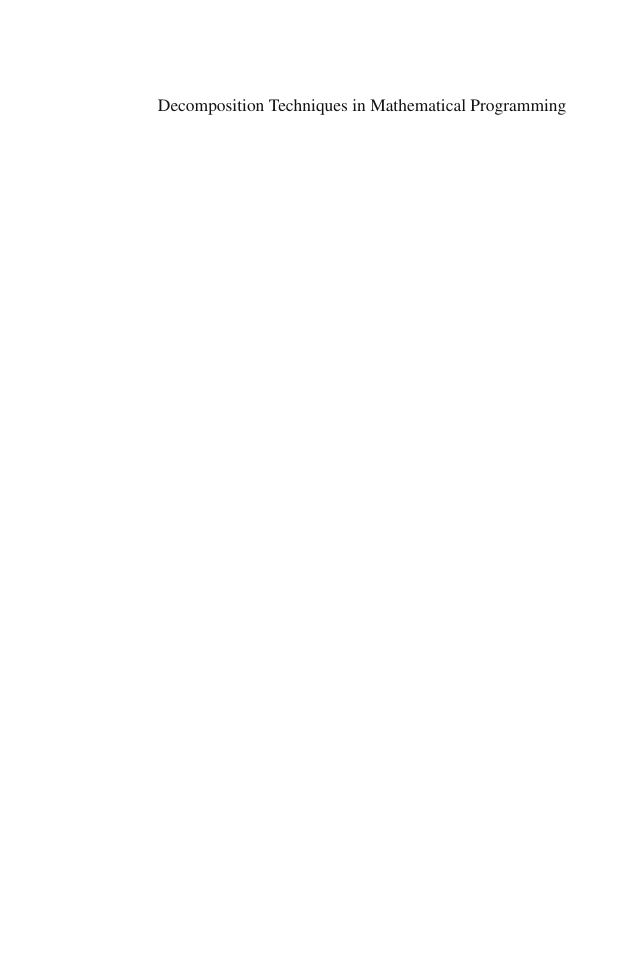
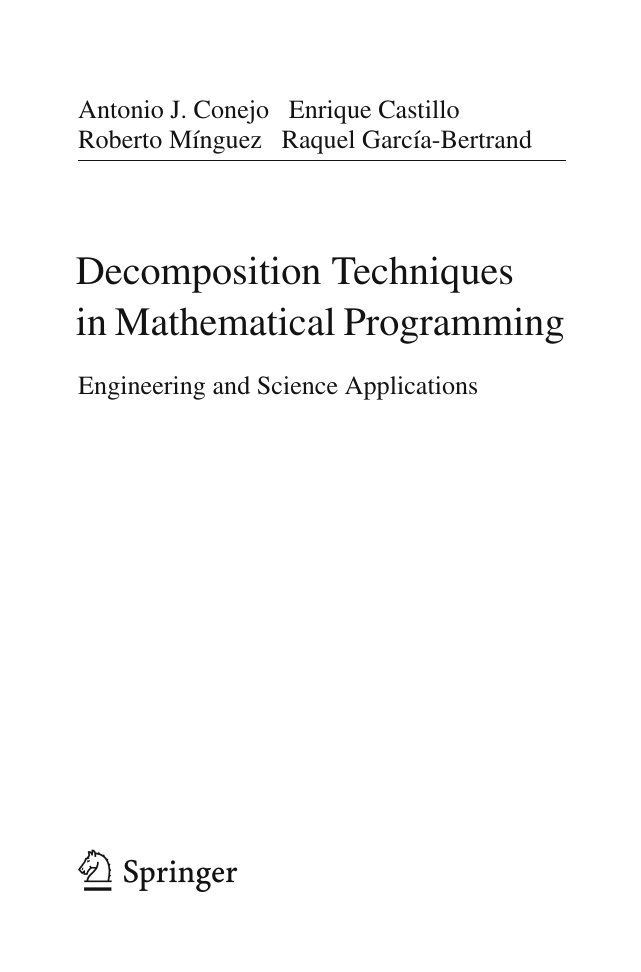
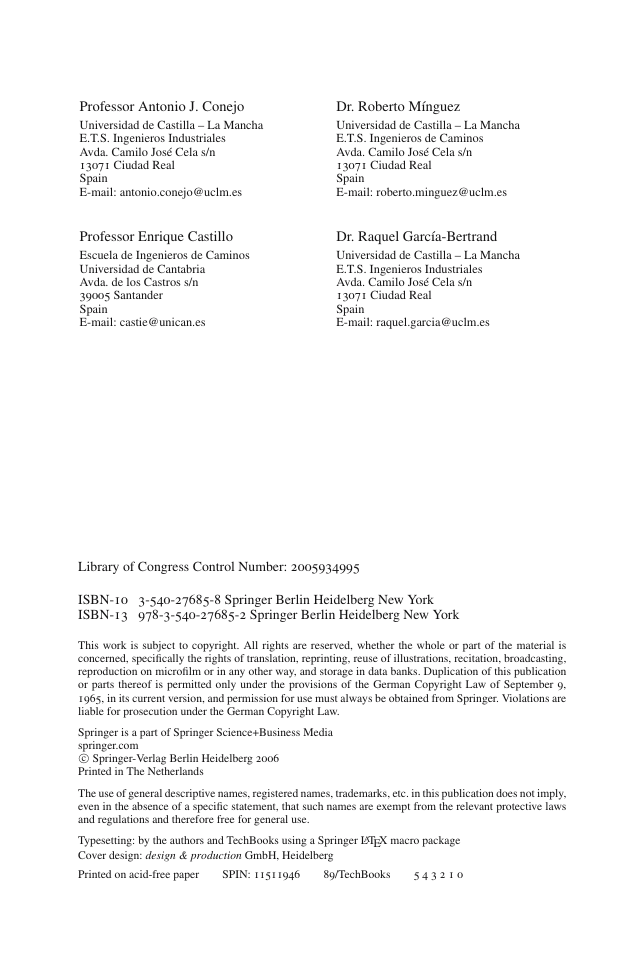

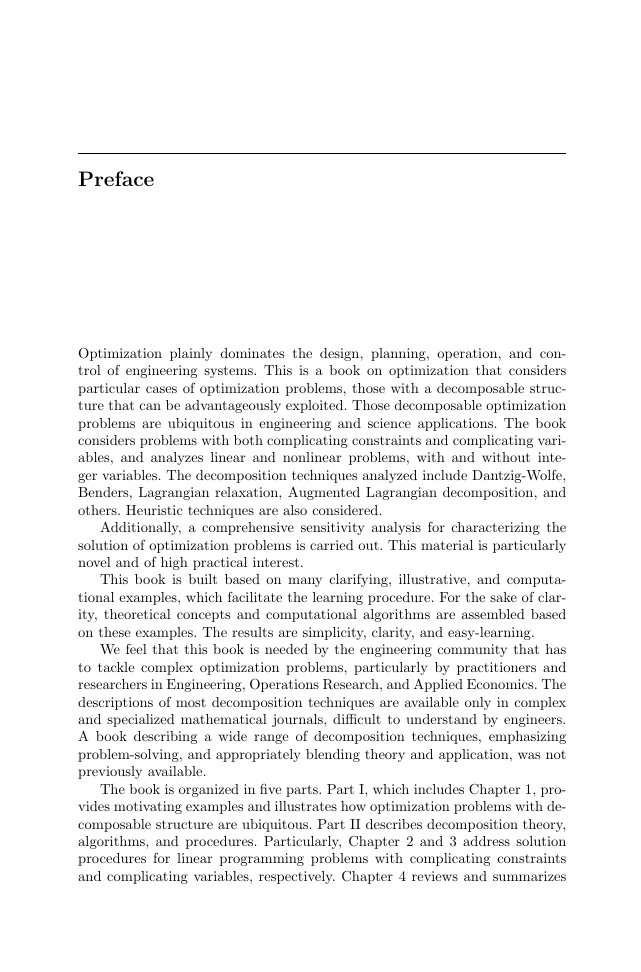
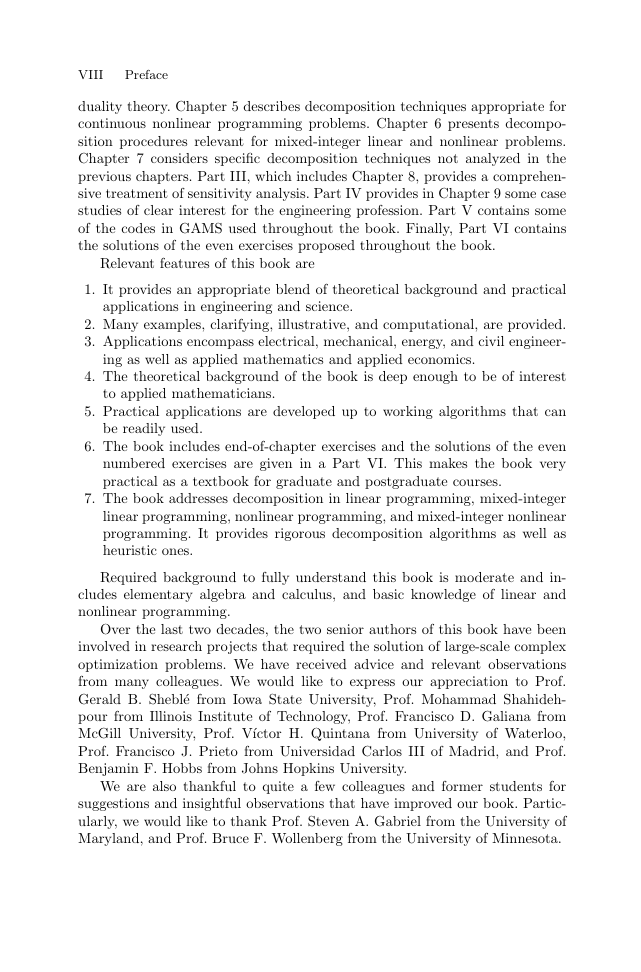

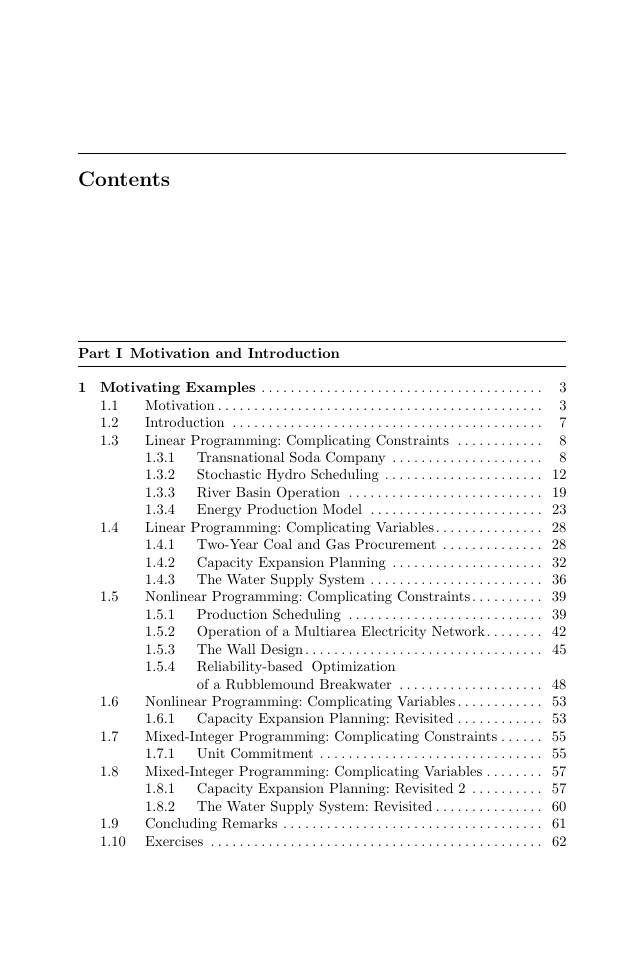








 2023年江西萍乡中考道德与法治真题及答案.doc
2023年江西萍乡中考道德与法治真题及答案.doc 2012年重庆南川中考生物真题及答案.doc
2012年重庆南川中考生物真题及答案.doc 2013年江西师范大学地理学综合及文艺理论基础考研真题.doc
2013年江西师范大学地理学综合及文艺理论基础考研真题.doc 2020年四川甘孜小升初语文真题及答案I卷.doc
2020年四川甘孜小升初语文真题及答案I卷.doc 2020年注册岩土工程师专业基础考试真题及答案.doc
2020年注册岩土工程师专业基础考试真题及答案.doc 2023-2024学年福建省厦门市九年级上学期数学月考试题及答案.doc
2023-2024学年福建省厦门市九年级上学期数学月考试题及答案.doc 2021-2022学年辽宁省沈阳市大东区九年级上学期语文期末试题及答案.doc
2021-2022学年辽宁省沈阳市大东区九年级上学期语文期末试题及答案.doc 2022-2023学年北京东城区初三第一学期物理期末试卷及答案.doc
2022-2023学年北京东城区初三第一学期物理期末试卷及答案.doc 2018上半年江西教师资格初中地理学科知识与教学能力真题及答案.doc
2018上半年江西教师资格初中地理学科知识与教学能力真题及答案.doc 2012年河北国家公务员申论考试真题及答案-省级.doc
2012年河北国家公务员申论考试真题及答案-省级.doc 2020-2021学年江苏省扬州市江都区邵樊片九年级上学期数学第一次质量检测试题及答案.doc
2020-2021学年江苏省扬州市江都区邵樊片九年级上学期数学第一次质量检测试题及答案.doc 2022下半年黑龙江教师资格证中学综合素质真题及答案.doc
2022下半年黑龙江教师资格证中学综合素质真题及答案.doc